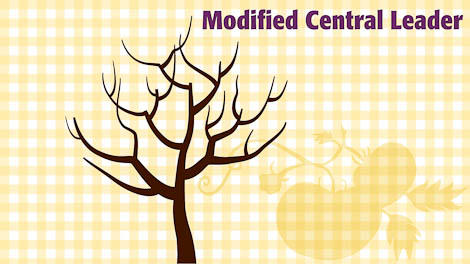Pruning in the Modified Central Leader Shape
Prune cherry, apricot, and pluot trees in the summer, not the winter. These trees are susceptible to water-borne diseases and winter pruning cuts provide dangerous openings for damage in rainy weather. What is it about fruit tree pruning that paralyzes otherwise confident gardeners? Once you have your long-term shape in mind, and know what time of year to prune, you're almost there.
When you have fruit tree questions, always come to our Fruit Tree Central, a well-organized source of research-based videos and articles about the selection, planting, pruning, and care of fruit trees. There are a handful of basic fruit tree shapes. The shape that works best for cherry, apricot, and pluot trees is the Modified Central Leader.
The filled in shape and leaves offer more protection from sunscald -- in fact, in the sunny Southwest this is an ideal shape for any fruit tree. Modified Central Leader can also be used for walnut, pomegranate, persimmon, apple, and pear trees.
How to Prune and Train a Fruit Tree from a Modified Central Leader Shape
In our video, Tricia trains and prunes a fruit tree with a Modified Central Leader. You can begin this process even with a young tree. A "central leader" is the traditional, vertical trunk we are used to seeing; the shape will include horizontal "scaffolding" branches.
Choose Four Permanent Scaffold Branches

Height
The first scaffold branches should grow from the trunk starting 18 to 24 inches above the ground.
Angles
For strong branches, find those growing from the trunk at 45 degrees to 60 degrees. If you don't have enough branches with good angles, find a perfectly placed branch with a narrow crotch and make a wooden spreader (as Tricia does in the video) to widen the crotch angle, use a wooden clothespin as a small spreader or try one of our tree limb spreaders.
Placement around the clock (or trunk)
Select branches that don't overlap each other. The ideal would be branches at 12 o'clock, 3 o'clock, 6 o'clock and 9 o'clock.
Vertical separation
It's best if the branches have vertical distance from each other of 8 to 10 inches.
Label the Scaffold Branches
 A simple tip, that saves a lot of pruning heartache, is to tie ribbons to the scaffold branches you've chosen. That way when you get flying with the loppers or pruners you can whiz along without worrying about accidentally chopping off a special branch. Tie ribbon or bird-scare tape to the branches you want to save -- use something wide and colorful, not just garden twine that you could overlook.
A simple tip, that saves a lot of pruning heartache, is to tie ribbons to the scaffold branches you've chosen. That way when you get flying with the loppers or pruners you can whiz along without worrying about accidentally chopping off a special branch. Tie ribbon or bird-scare tape to the branches you want to save -- use something wide and colorful, not just garden twine that you could overlook.
Head Back the Non-Scaffold Branches
What's a heading cut? It's a pruning cut that takes off part of the branch, but does not cut all the way to where the branch connects with the trunk. Go ahead and make heading cuts (to a length of 6 inches) on all the horizontal branches EXCEPT your labeled scaffold branches. Heading cuts stimulate growth.
Thin Branches to One Strong Leader
 Choose a leader -- the strongest, vertical shoot. Prune away the other vertical shoots, using a "thinning cut" where you remove the branch (instead of just shortening it). Do NOT cut right next to the trunk when you make a thinning cut, but cut outside the "collar" of the branch (the collar is the ridge where the branch joins the trunk).
Choose a leader -- the strongest, vertical shoot. Prune away the other vertical shoots, using a "thinning cut" where you remove the branch (instead of just shortening it). Do NOT cut right next to the trunk when you make a thinning cut, but cut outside the "collar" of the branch (the collar is the ridge where the branch joins the trunk).
Head Back the Central Leader

To stimulate growth, make a heading cut on your leader, taking it down to 20 inches above the TOP scaffolding branch.
Head Back the Scaffold Branches

Stimulate growth in your scaffolding branches too, with heading cuts. Cut them back by half or less to stimulate branching. See? Pruning is easy when you: 1) take your time 2) know what shape you're aiming for 3) have your tools sharp and ready to use 4) go one step at a time. Whether you want fruit trees, pruning tools, orchard ladders, or the latest information on organic gardening -- we have it for you!
For more information on pruning fruit trees, see our recent blog about high density planting in your home orchard. We also have helpful guides on pruning cane berries in your garden.


2 comments
Reva, oh yes. When you get the trees they should be removed from the plastic bag and placed in moist soil, shavings or compost until you are ready to plant.
My tree came with a bag covering all the roots, do I take the bag off before planting?